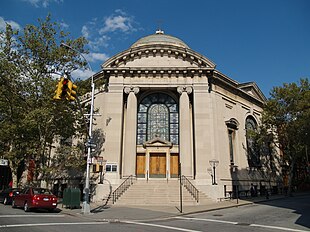| Congregation Beth Elohim | |
|---|---|
Hebrew: בֵּית אֱלֹהִים | |
 Sanctuary main entrance | |
| Religion | |
| Affiliation | Reform Judaism |
| Ecclesiastical or organisational status | Synagogue |
| Leadership |
|
| Status | Active |
| Location | |
| Location | 274 Garfield Place and Eighth Avenue, Park Slope, Brooklyn, New York City, New York |
| Country | United States |
Location in New York City | |
| Geographic coordinates | 40°40′16″N 73°58′27″W / 40.6712°N 73.9743°W |
| Architecture | |
| Architect(s) |
|
| Type | Synagogue |
| Style |
|
| Date established | 1861 (as a congregation) |
| Groundbreaking |
|
| Completed |
|
| Specifications | |
| Direction of façade | West (Sanctuary) |
| Capacity | 1,200 worshippers |
| Dome(s) | One |
| Materials | Cast stone |
| Website | |
| cbebk | |
| |
| Part of | Park Slope Historic District (ID80002636) |
| Significant dates | |
| Designated CP | November 21, 1980 |
| Designated NYCL | July 17, 1973 |
| [1][2][3][4][5][6][7] | |
Congregation Beth Elohim (Hebrew: בֵּית אֱלֹהִים, lit. 'House of God'), also known as the Garfield Temple and the Eighth Avenue Temple, is a Reform Jewish congregation and historic synagogue located at 274 Garfield Place and Eighth Avenue, in the Park Slope neighborhood of Brooklyn in New York City, New York, United States.
Founded in 1861 as a more liberal breakaway from Congregation Baith Israel, for the first 65 years it attempted four mergers with other congregations, including three with Baith Israel, all of which failed. The congregation completed its current Classical Revival synagogue building in 1910 and its "Jewish Deco" (Romanesque Revival and Art Deco) Temple House in 1929.[6][2] These two buildings were contributing properties to the Park Slope historic district, listed as a New York City Landmark district and listed on the National Register of Historic Places.[7][8]
The congregation went through difficult times during the Great Depression, and the bank almost foreclosed on its buildings in 1946.[2] Membership dropped significantly in the 1930s because of the Depression, grew after World War II, and dropped again in the 1960s and 1970s as a result of demographic shifts.[9][10] Programs for young children helped draw Jewish families back into the neighborhood and revitalize the membership.[9]
By 2006, Beth Elohim had over 1,000 members,[11] and, as of 2009[update], it was the largest and most active Reform congregation in Brooklyn,[12] the "oldest Brooklyn congregation that continues to function under its corporate name",[13] and its pulpit was the oldest in continuous use in any Brooklyn synagogue.[14] In 2009, it was listed by Newsweek as one of America's 25 "Most Vibrant" Jewish congregations.[15]
- ^ Cite error: The named reference
Leadershipwas invoked but never defined (see the help page). - ^ a b c Cite error: The named reference
Olitzky1996p228was invoked but never defined (see the help page). - ^ Cite error: The named reference
Kamil2005p152was invoked but never defined (see the help page). - ^ Cite error: The named reference
TheMainSanctuarywas invoked but never defined (see the help page). - ^ Cite error: The named reference
Morrone2001p375was invoked but never defined (see the help page). - ^ a b Cite error: The named reference
Morrone2001p376was invoked but never defined (see the help page). - ^ a b Cite error: The named reference
ParkSlopeHDDR1973was invoked but never defined (see the help page). - ^ Cite error: The named reference
NRHPNomination1979was invoked but never defined (see the help page). - ^ a b Cite error: The named reference
Sleeper1989p160was invoked but never defined (see the help page). - ^ Cite error: The named reference
TheTempleHousewas invoked but never defined (see the help page). - ^ Cite error: The named reference
Norsen2006was invoked but never defined (see the help page). - ^ Cite error: The named reference
Gersten2009was invoked but never defined (see the help page). - ^ Cite error: The named reference
Originswas invoked but never defined (see the help page). - ^ Cite error: The named reference
Bergman2001p314was invoked but never defined (see the help page). - ^ Cite error: The named reference
Newsweek20090404was invoked but never defined (see the help page).
